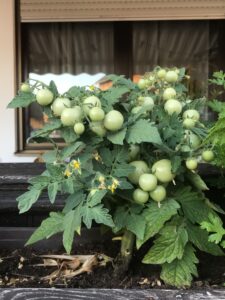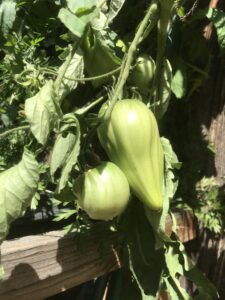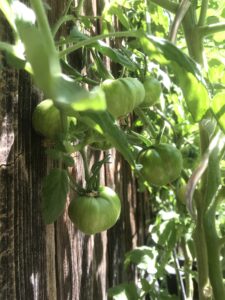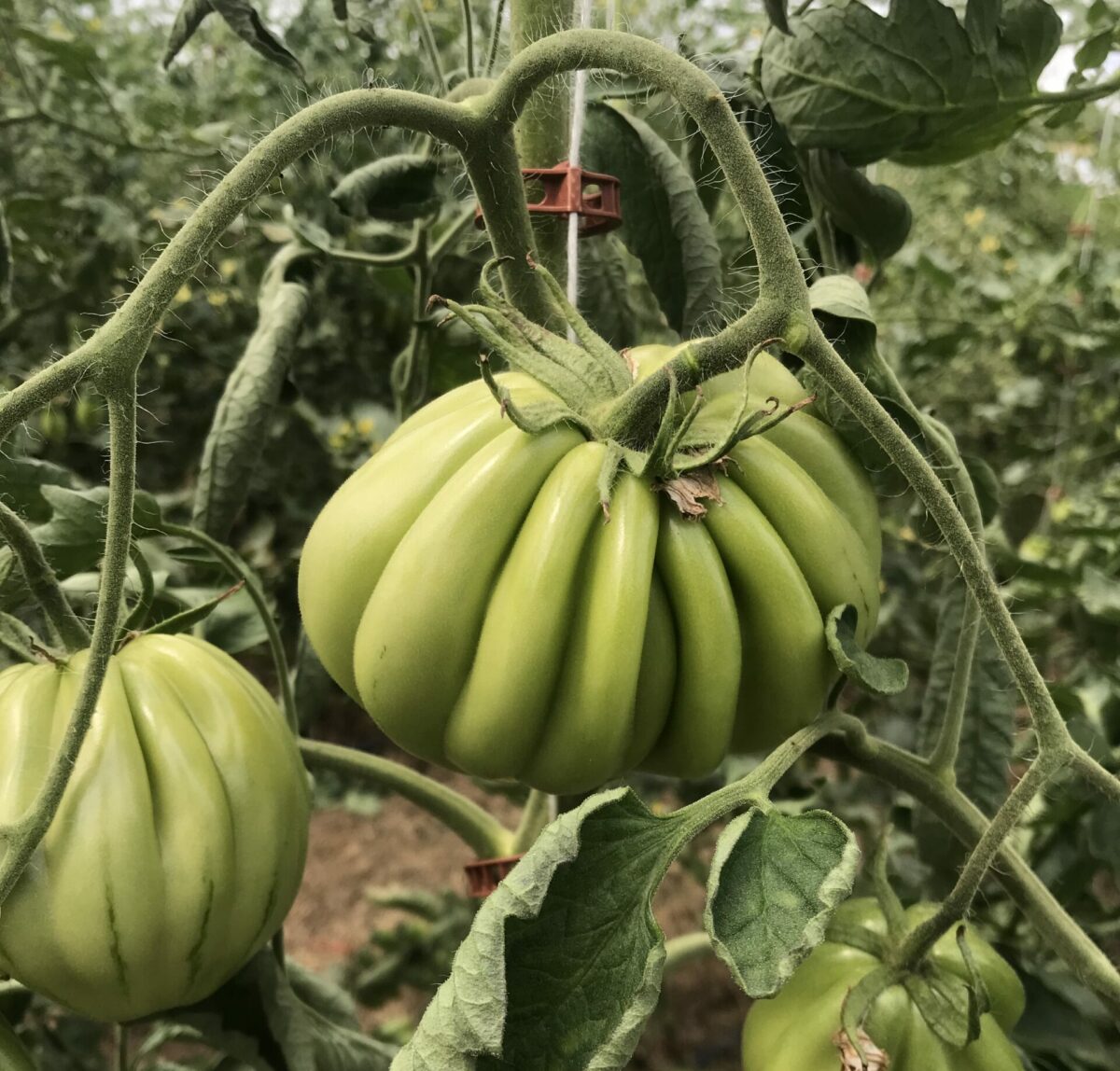Tomatoes are from the solanaceae family, which encompasses more than 2,500 species. Also known as the nightshade family, they can be found worldwide both in temperate and tropical climates, with the largest concentration in Central and South America. The plants can take the form of herbs, shrubs and trees, and can be both annual and perennials.
The solanaceae count for a great economical importance because many of the species are grown as food, such as aubergines, potatoes, chilli peppers, bell peppers and of course tomatoes. According to Magazine F, “cultivars are chosen to be grown in consideration for marketability and productivity based on adaptability to soil and climate, resistance, tolerance, and quality of the fruit.”
Fun fact: you can graft a tomato plant onto potato roots to obtain a “pomatier” that produces both tomatoes and potatoes.
1 – How to choose my tomatoes?
According to botanist A. de Candolle, the world counts around 25,000 varieties of tomatoes, and would be originally from Peru. They differ in size, colour, shape, growth speed, texture, flavour and aroma.
Choose the variety that suits your taste and needs
Here is a small selection of tomato plants to give you inspiration on which varieties to cultivate in your own garden:
- The variety Aztek is ideal for small surfaces. It grows as a tiny bush, which is perfect for a pot on a balcony!

- The variety Beefsteak is one of the most popular tomato cultivars. Its large fruit have a chewy texture and are high in moisture. You can use them for making sauce, juice, in salads or hamburgers.

- The variety Green Zebra provides fruit covered with vertical stripes that do not crack easily, which are great as pickles!

And a few other ones: Cherokee Purple, Andine Cornue, Super Sweet 100, Cosmonaut Volkov, San Marzano, Super Sunroad, Betatini, Black Krim, Brandywine, Celebrity, Chocolate Stripes, Black Cherry, Early Girl, Lemon Boy.
Indeterminate growth vs. determinate growth tomatoes
Something important to know when making your selection is that there are two different types of tomato plants. The difference is found on the way they grow: “indeterminately” or “determinately”.
Tomato plants with indeterminate growth do not have a growth limit and live longer. However, they generally need to be pruned and be hold with stakes. On the other hand, tomato plants with determinate growth have a “bush-like” shape and live shorter. Contrary to the other ones, they don’t need to be pruned, and all fruit appear at the same time.
| Indeterminate growth | Determinate growth |
|---|---|
| No growth limit Longer life Need to be pruned Stakes required | Short/bush-like Short life No need to be pruned All fruit at the same time |
When thinking about determinate growth tomato, I always remember one of the most poetic scenes I’ve seen in a documentary about farming. In When Tomatoes Met Wagner, people from a Greek village play Wagner music to their tomatoes in order to help them grow. You can have a look at the trailer below:
Hybrid vs. heirloom cultivars
Another thing to keep in mind is that some seeds are hybrid F1, while other ones are heirloom seeds. The former come from seeds that have been selected for their characteristics like chocks or transport resistance. Their fruit will all have the same colour and shape, but won’t be reproducible. The latter are old cultivars of a plant that has grown with natural processes. They can be reproduced identically from one year to the other. Moreover, their genetics patrimony allows themselves to adapt to their environment, climate change and gardening practices.
| Heirlooms | Hybrids |
|---|---|
| Free to use More variety Can save the seeds Usually more tasty | Patented Uniformity Bigger harvest Non-reproducible Often more resistant |
2 – What are the needs of my tomatoes?
Tomato plants require at least 15 °C to grow and feel better in a hot-tempered climate. An ideal temperature is > 25 °C for an optimal growth. They also require a very rich and deep soil for growing efficiently.
The bigger the tomatoes will be, the more the plant will have to be exposed to the sun. Cherries require min. 3h of sun during the day, small tomatoes (<85g) min 4-5h, medium tomatoes (85-225g) min 5-6h and large tomatoes (>225g) min 7-8h.
3 – Planting: best practices
I won’t go into the details regarding how to plant tomatoes. First because each variety has its own specificities, and second because seeds packages already provide basic explanations.
Sowing
If you’re doing your seedlings yourself, tomato seeds germinate about 1 mm at 27 °C to 30 °C three days after seeding. When I worked in 2023 at SoLaWi Ferni in Regenstauf, Sophie (one of the co-owners) showed me how to sow plants efficiently. This works for every plant. What might change is how deep you would need to put the seed. Generally, the bigger the seed is (like beans for example), the deeper the seed should be. Here is a drawing that I made after her explanations:

- Take some earth in your hand and place it on the cultivation tray;
- Repeat until the tray is covered with earth and spread it onto the gaps;
- Once the gaps are full, make a small hole in each gap with your forefinger (the bigger your seed is, the deeper the hole will have to be);
- Add your seeds into the holes;
- Add more earth and gently spread it over the tray, making sure the seeds remain in the holes;
- Water with the soft jet of your watering can.
Planting
Tomato plants usually must be planted to a 40 to 45 cm depth and need at least 40 to 45 cm wide space.
4 – How to tend to my tomatoes?
In this part, I am sharing with you some tips that I got when working with farmers while Wwoofing in Sweden and Germany.
Humidity: your worse enemy?
Having a good airflow is super important in a greenhouse, in order to avoid the development of diseases. The air should be able to go through the whole greenhouse, from one side to the other. One tip is to cut the first few leaves at the bottom of each plant to keep off humidity stagnancy.
Facts vs. science: who’s right?
Bumblebees
You can use bumblebee hives in the greenhouse in order to increase pollination. However, a farmer I used to work with didn’t notice a difference in terms of fruit growing between last year and this year, when she didn’t put a hive.
Note: tomatoes are self-fertile, which means that they hold both the male and female in one flower. The role of bumblebees is just to help shake the plant so that male and female can meet.
Basil association
Tomatoes and basil apparently grow well together. With their high smell, Basil repels pests away from tomatoes. They also provide nutrients to one another. These pieces of information have not been scientifically proven but adding basil plants at least help to optimise the space in the greenhouse or in the field.
Water the right way
Don’t water tomatoes on their leaves. It will accelerate the apparition of diseases. When possible, water by capillarity.
Suckers or not suckers?
Most farmers prune tomatoes because of several reasons:
- Let the air flow go through the greenhouse to avoid too much humidity. Otherwise, the plants would develop diseases;
- We want tomato plants to focus on growing ripen fruit and not too many leaves. They wouldn’t be ready by the end of the season when cold temperatures start;
- Optimise space in the greenhouse not to have them go all over the place;
- Harvest more easily and see where the fruit are.
Tip: prune tomato plants when they are the driest because it reduces the risk of diseases.
References
All About Biology. (2021, September 17). Family Solanaceae | Solanaceae Family | B.Sc. , M.Sc. Botany [Video]. YouTube. https://www.youtube.com/watch?v=IrXa2PQ_Zq0
Contributeurs aux projets Wikimedia. (2016). Origine des plantes cultivées. Wikisource. https://fr.wikisource.org/wiki/Origine_des_plantes_cultiv%C3%A9es
Five-minute families. (2022, August 20). Solanaceae [Video]. YouTube. https://www.youtube.com/watch?v=xFIWHMScU3Q
Magazine F 4th Issue: TOMATO. (2023, August 4). Reading-F. https://www.reading-f.com/magazine-f-tomato/
visionsdureel. (2019, March 12). Trailer | When Tomatoes met Wagner | Marianna Economou [Video]. YouTube. https://www.youtube.com/watch?v=_uftwPx9KGo

